Taste of Mexico: Flor de calabaza

The squash plant, or “flor de calabaza” as it is ubiquitously known in Mexico, was a fundamental part of the milpa system for pre-Columbian cultures. But perhaps even more important than the plant itself was the role of its flowers.
In the Mesoamerican cosmovision, flowers were everything. They were medicine, food, decoration, pigment, offering, symbol, omen and poetry.

In societies ruled by agriculture, like theirs, flowers marked the beginning of the agricultural cycle. Because of that, they represented abundance and renewal. Like us, pre-Columbian peoples saw flowers as something delicate, so fragile that they also symbolized the profound respect they held for the balance required by nature — and, by extension, for the gods who manifested through nature itself.
The diverse foundational myths across Indigenous cultures reveal the profound reverence forsacred plants and flowers. Another indication of their importance is the depiction of flowers in murals, pottery, and other archaeological pieces. In Teotihuacan, for instance —the “City of the Gods” — the depiction of flowers was associated with music, poetry, and the beauty of language.
Imagine eating something that carries all those meanings.
Squash blossom
According to archaeological records, the squash was the first plant cultivated by Mesoamericans around 10,000 years ago. And not a single part of it went to waste: the seeds, the flesh, the stem, and of course, the flower were used in some way.
The blossom, known in Nahuatl as ayoxóchquilitl — according to the chronicler Fray Bernardino de Sahagún — commonly eaten, usually cooked, or added to stews.
View this post on Instagram
Harvesting the blossoms was — and still is — a delicate event. You have to pick them early in the morning, before the sun wilts them. They bloom only for a single day, so timing is everything. And you must handle them with care, remembering that ancient respect for the gifts of the earth.
Flor de calabaza today
This humble field food has made a spectacular leap into Mexico’s most high-end kitchens. And it’s no wonder — its flavor is extraordinary: slightly sweet, slightly herbaceous. Its delicate taste makes it a star ingredient in quesadillas, soups, creamy stews, tamales, fritters and any dish you can think of.
My favorite way to eat squash blossoms? In a quesadilla with epazote. But equally satisfying is squash blossom soup with young corn and diced zucchini, commonly known as sopa de milpa. Not only is it delicious — it’s also incredibly nutritious.
Super flower
If you’re looking for the perfect nutritional sidekick to your meal, squash blossoms are it. A small bunch is packed with vitamins A, B1, B2, B3, B9, and C. They also contain significant amounts of calcium, iron, phosphorus, potassium and magnesium, plus flavonoids and antioxidants.
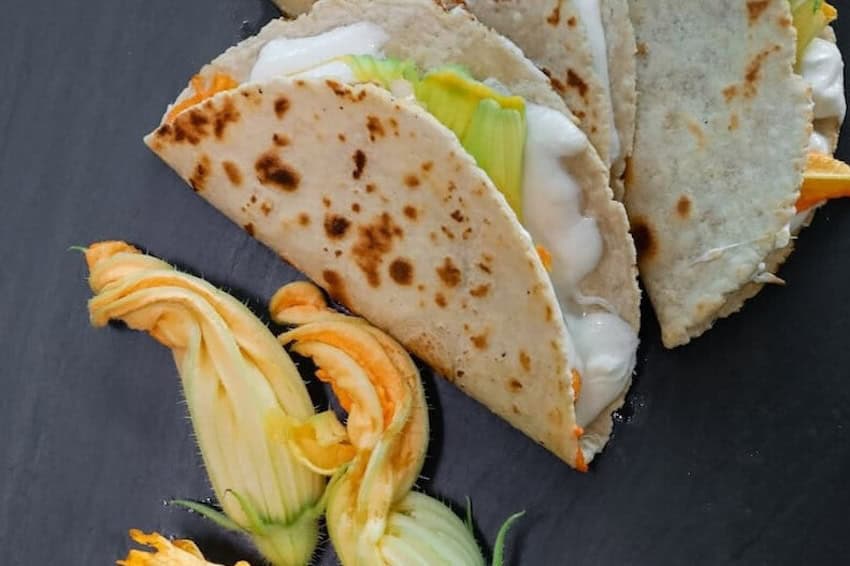
So what does this mean for your health? Squash blossoms can help prevent osteoporosis, promote healthy growth in children, and support strong eyesight. They’re also great for urinary health, boost cardiovascular function, lower cholesterol, support pregnancy, and even help fight the common cold.
In short, squash blossoms are a bona fide superfood.
So, my friends, I know you’re going to want to try this delight for yourselves. Here’s my recipe for Sopa de Milpa — a bowl that’s as comforting as it is meaningful.
Milpa Soup Recipe (Serves 4–6)
Ingredients
Instructions
Notes:
Amigos, I like to think that eating this squash blossom soup isn’t just about honoring Mexican culinary traditions — it’s also a beautiful act of reconnecting with the ancient reverence for nature and its delicate balance.
And, don’t you think there’s something wildly luxurious about eating the colorful and delicious flor de calabaza?
María Meléndez is a Mexico City food blogger and influencer.
Robinson Crusoe in Cabo San Lucas

When former castaway Alexander Selkirk returned to England in 1711, eight years after he had left, it was with the then-fabulous sum of 800 pounds in his pocket. Now wealthy, Selkirk would also become famous a year later, after the man who had rescued him from his desert island and helped make him rich, Captain Woodes Rogers, published his account of their adventures.
In 1713, Selkirk’s fame got another boost courtesy of writer Richard Steele, who published an interview with Selkirk in the magazine The Englishman about the sailor’s adventures during the four years and four months he spent marooned on Más a Tierra, 400 miles off the coast of Chile. One man who was certainly reading was Daniel Defoe, another prominent writer of the time. Six years later, Defoe would pen what is often called the first novel ever written in the English language: “Robinson Crusoe.” In the 300 years since its first appearance, it has never been out of print.

It should be noted that “Robinson Crusoe” was a fictionalized account that doesn’t exactly match up with Selkirk’s story. Unlike Selkirk, Crusoe was stranded in the Caribbean, not the Pacific; he spent not four but 28 years on his island; and he wasn’t alone for all of it, not after the appearance of the man Friday. But one look at the book’s original frontispiece, with its hero clad in goatskins à la Selkirk, and it was clear that the man who had recently been a public sensation was also a major inspiration for Defoe.
Marooned and rescued
Born and raised as Alexander Selcraig in Scotland, Selkirk, as he came to be known, was a less-than-saintly character who ran away to sea after beating up several members of his family and indulging in what the Church of Scotland judged to be illicit fornication.
Selkirk proved to be a capable navigator, serving as the sailing master aboard the Cinque Ports, one of two ships under the command of Captain William Dampier, whose privateering mission was a legal sanction to attack Spanish ships. Although Dampier was the leader of the expedition, Selkirk answered to Captain Thomas Stradling.
In 1704, after several skirmishes with the Spanish and the two ships being separated, Selkirk decided the Cinque Ports was no longer seaworthy, and he demanded that Stradling put him ashore in the Juan Fernández Islands, a remote archipelago west of Chile.
Once ashore, however, Selkirk changed his mind and begged to be taken back onboard. Stradling mocked him and refused. This was a fortunate occurrence for Selkirk, as it turned out, since he was right about the Cinque Ports’ seaworthiness: she would sink, and her surviving captain and crew would be imprisoned in Peru.

Selkirk and Rogers get rich in Cabo San Lucas
Four years and four months later, in February 1709, three ships commanded by Woodes Rogers would arrive and rescue the barefoot and goatskin-clad Selkirk from his island exile, although he had weathered it well otherwise and was in excellent health. William Dampier, along for this voyage, too, recognized Selkirk. Today, the island where Selkirk was marooned is known as Robinson Crusoe, and another in the archipelago is called Alejandro Selkirk.
Rogers’ mission was much the same as Dampier’s had been previously: find and attack Spanish ships. It was legalized piracy that promised plenty of booty, particularly if they could capture one of the ships that sailed on the Manila galleon route, or Nao de China, as it was known in Mexico. These ships were a key link on what was one of the first global trade routes, traveling annually between Manila in the Philippines and Acapulco. They brought Asian silks, spices and other treasures, many of which would eventually find their way back to Spain.
Naturally, these treasure-laden ships were like catnip to English pirates and privateers, who would hide behind Land’s End in Cabo San Lucas’ bay to await them, since the galleons would typically make their way to the estuary in San José del Cabo to replenish their freshwater supplies before traveling on to Acapulco.
The most lucrative of these attacks occurred in 1587 when Thomas Cavendish sacked the Santa Ana in Bahía Cabo San Lucas. Woodes Rogers and crew, including Selkirk, would write the next great chapter in this ongoing piratical history on Dec. 22, 1709, when they outfought the Nuestra Señora de la Encarnación y Desengaño, which had become separated from her sister ship en route from Manila.
A few days later, the Begoña, a more heavily armed and well-captained galleon, would repulse the English assailants and make her way successfully to Acapulco. But by that time, Rogers’ crew had thoroughly looted the Nuestra Señora, which they renamed the Bachelor, and would sail back to England with Selkirk as sailing master. Their fortunes were assured.

Robinson Crusoe and the Pericues
The attack on the Nuestra Señora is a great pirate tale, but from the perspective of Los Cabos’ history and culture, not the most interesting part of Rogers’ narrative in “A Cruising Voyage Round the World,” the book he wrote about his circumnavigation of the globe. That’s because during the months Rogers, Selkirk, and crew were waiting to attack the galleons, they spent time interacting with the Pericú, the original inhabitants of Los Cabos.
Crucially, Rogers was one of the first to write about these now-culturally extinct people, who had lived on the southernmost part of the Baja California peninsula for about 12,000 years. In 1730, a mission would be founded by Jesuits in San José del Cabo to attempt to Christianize the Pericú, and they would be written about at length by many other sources than the early Spanish and English sailors.
However, Rogers provided a particularly indelible historical portrait of the 300 or so Pericúes then in Cabo San Lucas: “They had large limbs, were straight tall, and of a much blacker complexion than any other people that I had seen in the South Seas. Their hair long, black, and straight, which hung down to their thighs. The men stark naked, and the women had a covering of leaves over their privities, or little clouts made of silk grass, or the skins of birds and beasts.”
He wrote of their chief, whose head was “adorn’d with feathers,” and raved about their skills as fishermen, noting that “we saw no nets or hooks, but wooden instruments, with which they strike the fish very dextrously, and dive to admiration. Some of our sailors told me they saw one of ’em dive with his instrument, and whilst he was under water put up his striker with a fish on the point of it, which was taken off by another that watch’d by him on a bark log.”
They also engaged in an active trade, exchanging knives for the fish the Pericúes so easily and deftly caught. So yes, not only was Robinson Crusoe in Cabo, he’s an example proving the area was a hub of activity long before the modern age of tourism.
Chris Sands is the Cabo San Lucas local expert for the USA Today travel website 10 Best, writer of Fodor’s Los Cabos travel guidebook and a contributor to numerous websites and publications, including Tasting Table, Marriott Bonvoy Traveler, Forbes Travel Guide, Porthole Cruise, Cabo Living and Mexico News Daily. His specialty is travel-related content and lifestyle features focused on food, wine and golf.
Meet the nonprofit preparing Mexico for climate change

Now celebrating its 15th anniversary, el Maíz Más Pequeño is an innovative nonprofit organization training teachers to prepare communities to adapt to climate change. Their educational programs promote the participation of young people, teachers, parents and communities as a whole.
“Our mission,” says director and cofounder Henry Miller, “is to do everything possible to prepare society for climate change. Over the last 15 years, we’ve worked with Indigenous communities throughout Mexico, collaborating with local, national and international organizations, including the UN Food and Agriculture Organization.”
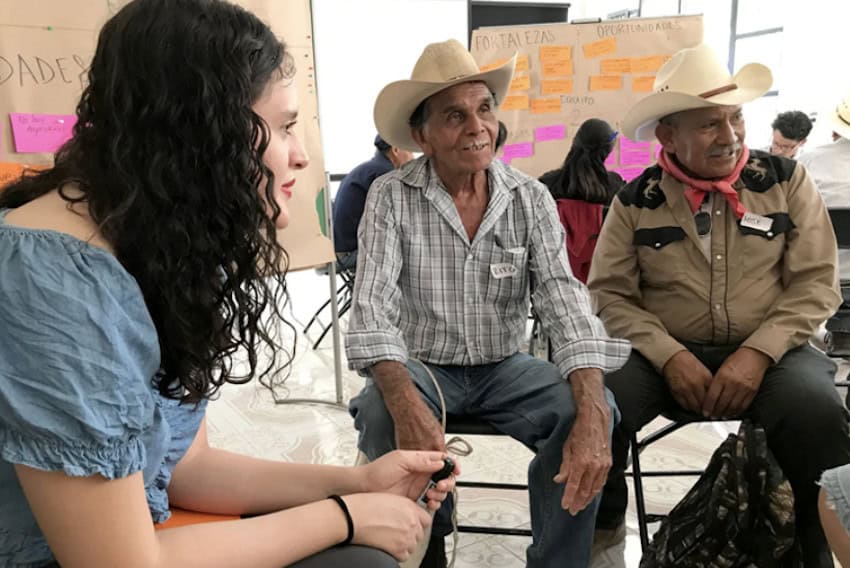
“We’ve had the opportunity to develop an understanding of the problems facing children, parents and teachers, and with that understanding, we have created an educational model for climate change adaptation.”
The organization’s current initiative is called the Learning and Transition Laboratory for Climate Change (labAT). This educational tool helps teachers conduct community diagnostics, identify key problems, and develop school projects that address local circumstances.
“We have just completed our first full school year in the state of Querétaro,” explains Miller, “specifically in the Sierra Gorda region, where we work with teachers representing 26 schools in 26 communities.”
“This tool is designed to help teachers work with students and parents to identify community problems, risks and vulnerabilities, as well as areas of resilience and available resources. Teachers are then able to bring this hyper-local information into their lesson plans for the development of school projects that address these specific community situations.”
Think globally, act locally
While Miller affirms that the labAT educational model aligns with international standards such as the Paris Climate Accords, Sendai Framework for Disaster Risk Reduction and the UN Sustainable Development Goals, as well as Mexico’s national educational standards, he also stresses that centering local conditions is its strength.
“I want to underline the importance of local information for climate change adaptation. Our work aligns with the Paris Accords and the UN 2030 agenda, and these international frameworks are very important — but the key is that adaptation has to happen locally. People need options at the local level, they need access to knowledge, and they need access to power structures.”
The organization’s diagnostic and educational tool, which has received certification from Mexico’s National Copyright Institute (Indautor), focuses on three reference points: each family’s domestic economy; the community’s territory, such as the local watershed; and good governance.

Empowering educators and re-centering them as community leaders
El Maíz Más Pequeño aims to support and empower teachers, re-centering them as community leaders and sources of information and resources. “We definitely want to contribute to strengthening teachers,” says Henry Miller. “We remind them that they can be agents of change and that they are not alone.”
“Along those lines,” he continues, “our tool has an element of social cartography: we begin by asking students to draw their community, putting the school in the center as the information source. Then we ask them to note places or elements of their community that are considered resources and others that are considered dangerous or risky.”
Miller described seeing mosquitos drawn for the first time, and marked as a risk, on the community map created by a group of primary school students in the remote village of La Barranca in Pinal de Amoles, Querétaro. This community is located at such a high elevation that they’d never had to worry about mosquitos before. “But because of climate change, they’re now dealing with mosquitoes, a biological indicator showing that temperatures are warming. The increase in mosquitos in many areas has led to more outbreaks of dengue fever all over the country.”
These children and their parents also identified forest fires, illegal logging and violence as threats to their community. Not only do these diagnostic exercises provide critical information, they also develop a language with which to talk about the problems, as well as uncover knowledge of actors who can help.
In today’s world, parents have less certainty about the future their children will face, notes Miller. “We no longer have the luxury of certainty, so we have to build resilience, in the form of knowledge, emotional intelligence and the ability to work with other local actors for the common benefit.”
The organization then helps teachers systematize their integration of climate change adaptation content into their lesson plans by defining climate-related vulnerabilities and sources of resilience in each layer of the community: at the level of a family’s domestic economy, in the physical territory and in government. “We exist to bring climate change into the national curriculum in a user-friendly way,” Miller says.
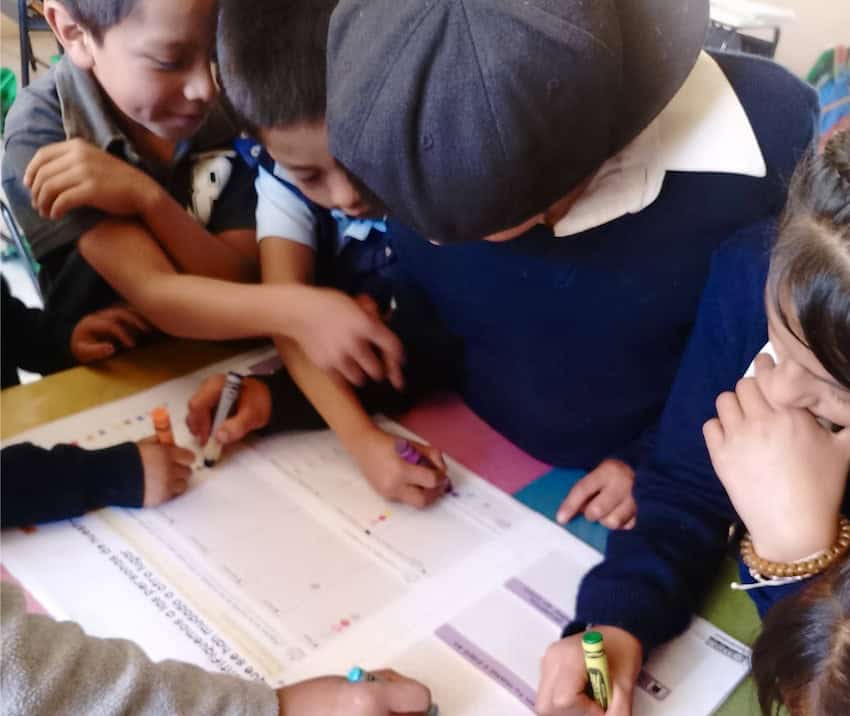
Building networks to support climate change adaptations
By working with parents of students in each school, El Maíz Más Pequeño aims to improve the quality of information available to community members, support healthy community decision-making and identify and expand networks of actors working to support climate change adaptation projects.
Miller explained that the organization also hopes to contribute to a critical national risk management atlas, working with the National Institute for Ecology and Climate Change (INECC) and Civil Protection. This initiative aims to improve the quality of information available to national policymakers as well as local actors, enhancing the national government’s ability to prepare citizens for climate change adaptations.
“Climate change adaptation is a form of risk management,” Miller says. ”It is crucial to reduce the time needed to respond to local climate-related problems and bring better tools to the fight.”
Support the innovative work of El Maíz Más Pequeño
Now celebrating its 15th anniversary, the organization hopes to greatly expand their reach in the coming years. In particular they plan to digitize their educational tools as an application and thereby make these valuable resources more accessible to teachers, parents, students and community leaders across the country. They are currently looking for corporate support to make this possible. To learn more about El Maíz Más Pequeño and support the organization’s important work, visit elmaizmaspequeno.org.
Based in San Miguel de Allende, Ann Marie Jackson is a writer and NGO leader who previously worked for the U.S. Department of State. Her award-winning novel “The Broken Hummingbird,” which is set in San Miguel de Allende, came out in October 2023. Ann Marie can be reached through her website, annmariejacksonauthor.com.
As Lake Texcoco recovers, rising water swallows the ruins of the canceled airport

Heavy summer rains in central Mexico are revitalizing Lake Texcoco, submerging the remnants of the partially built Mexico City airport project and marking a symbolic turn in a decades-long debate over land use and ecological restoration.
According to the National Commission of Natural Protected Areas (CONANP), nearly two months of persistent rainfall have brought water levels in Lake Texcoco to depths reaching four meters.
La estructura del aeropuerto de Texcoco está hoy totalmente inundada convirtiéndose en un cuerpo de agua de un ecosistema que nunca debió ser desecado.🧵 pic.twitter.com/ycYy85sGZj
— César Pineda (@cesarpinedar) July 7, 2025
The waters have covered the partially constructed terminal and the concrete foundations left after work on what was to be a new Mexico City International Airport was abruptly cancelled nearly seven years ago.
Being built on an ancient lakebed in Texcoco, México state, the airport was the signature infrastructure project of former president Enrique Peña Nieto (2012-2018).
The controversial U.S. $15-billion project was canceled by Andrés Manuel López Obrador near the start of his six-year term in 2018, following a public referendum and a widely criticized four-day consultation on the project.
Since then, Lake Texcoco has been inaugurated as an ecological park last August and subsequently designated as an Ecohydrology Demonstration Site by UNESCO — the first of its kind in Mexico.
Now, thanks to the rains, the waters are rising.
“The 100 hectares of the terminal building are partially flooded, but we expect that by the end of September — with the end of the rainy season — the level at that site will rise two more meters,” said Jorge Daniel Fonseca Cando, director of the Texcoco Lake Natural Resources Protection Area.
The higher water level “will allow us to see a more unified body of water that, we estimate, will measure approximately 700 hectares within the Texcoco Lake Ecological Park area.” The full ecological area stretches across 14,030 hectares, 10,000 of which are categorized as lakebed.
Community members and activists, notably from the People’s Front in Defense of the Land (FPDT), have led efforts for years to prevent construction and restore the land.
On a recent tour for the media, FPDT leaders showed over 1,800 hectares already filled with water in the now protected area.
FPDT leader Ignacio del Valle Medina expressed hope of surpassing 4,000 hectares by the season’s end.
¡El Lago de Texcoco resiste, no se rinde! 🌊🦅
Está en el centro de la bandera… y en el corazón de todas y todos.Hoy lo reafirmamos junto a Nacho y Trini, compañeros del Frente de Pueblos en Defensa de la Tierra: ejemplo de dignidad, lucha y amor por el territorio.
🌱 ¡Que el… pic.twitter.com/iOyI5JCSO2
— Adán Peña (@adanmexic) July 17, 2025
“What we can tell you from here, from the lake, is that the people and the water are here, and we will erase every trace left by that deadly project, and we will reclaim Lake Texcoco for Mexico, for the nation’s capital and the eastern part of the State of México,” he said.
Simultaneously, Lake Texcoco is witnessing a resurgence in native flora and fauna, with recent counts registering 230,000 migratory birds — including seven species unseen in years — and thriving populations of aquatic plants and shorebirds.
The lake, part of the basin of the Valley of Mexico, and its system of lagoons and wetlands provide a lifeline for a polluted valley that includes Mexico City and its metropolitan area.
“Lake Texcoco is beginning to recover and refuses to disappear,” said FPDT member Arturo González Cando. “We will be able to concentrate up to seven million cubic meters of water by the end of the rainy season.”
The structural remains of the failed airport, such as sunken concrete piles and foundation wells, are now submerged under millions of cubic meters of water, creating new habitats. The lake area is home to 250 species of flora and 370 species of fauna.
Restoration efforts by the FPDT, CONANP and local organizations have involved redirecting nearby rivers and building dams to further expand water storage.
The architect behind the restoration, Iñaki Echeverría, helped inaugurate the ecological park — now one of the world’s largest urban green spaces — last August, shortly before the end of López Obrador’s term.
“This is what we defended, a unique life in the center of the country,” González Cando said, highlighting the area’s importance as a natural barrier against urban sprawl and a crucial reservoir for the Valley of Mexico’s hydrological future.
With reports from El País, La Jornada, Sin Embargo and El Economista
Mexicans in US can avoid remittance tax with government Finabien cards, Sheinbaum says
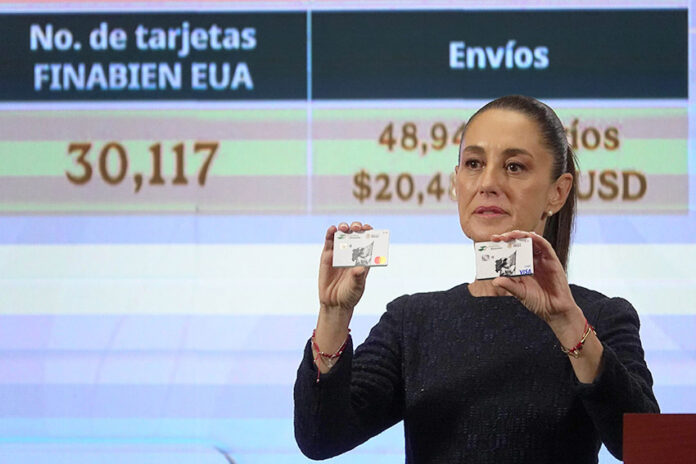
President Claudia Sheinbaum on Friday promoted a government bank card that can help Mexicans living in the United States avoid the new remittance tax.
Sheinbaum recommended the new services available with the Finabien bank card, originally created in 2024 by the federal government’s Financial Institution for Well-being (Finabien), brandishing a card for the cameras during her morning press conference.
“It’s a very simple way to send remittances electronically and avoid making cash transfers,” Sheinbaum said.
The newest service offers direct deposit operations, allowing cardholders’ wages to be sent directly to the card by employers or transferred using authorized institutions. Additionally, remittances can be made more economically and will allow cardholders to circumvent the U.S. remittance tax, the president said.
The new tax — which goes into effect on Jan. 1, 2026 — is a federal excise tax applied directly to outbound money transfers. Essentially, it is a fee charged across the board to each person who sends funds out of the U.S.
The Finabien card can be acquired at 53 consulates in the U.S., by mail or via digital application at miconsulado.sre.gob.mx. And accounts can be accessed at 1,700 sites in Mexico.
Finabien director Rocío Mejía Flores said the transaction fee has been reduced from US $3.99 to US $2.99, benefiting the 30,000 cardholders in the United States. Sending remittances only requires a destination and amount to be sent, with restrictions.
Mejía Flores said senders are limited to US $2,500 per day and no more than US $10,000 per month.
In addition to the Finabien card promotion, Foreign Relations Minister Juan Ramón de la Fuente emphasized the administration’s new approach toward consular services available to nationals residing in the U.S.
Describing consular attention as a priority, De la Fuente said his ministry (SRE) has upgraded its digital capabilities and consulates now feature:
- An online appointment platform to combat bureaucratic fraud.
- A digital one-stop shop, centralizing all procedures.
- The elimination of fees for consular procedures.
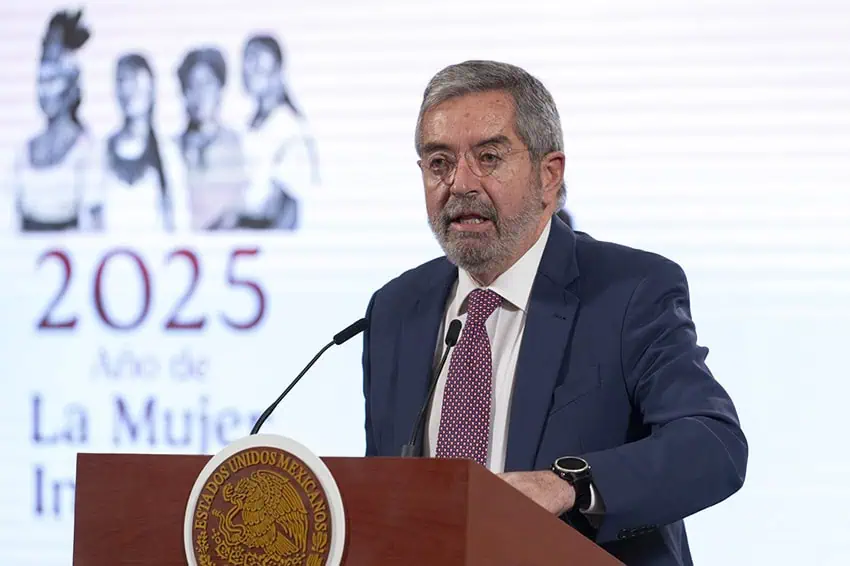
The foreign minister spoke of the emergency phone numbers designated to help nationals detained for immigration violations or subject to deportation. The SRE has two 24-hour emergency numbers from which agents will dispense legal advice and provide consular support: 520-623-7874 in the U.S. and 079 in Mexico.
De la Fuente also praised the roll-out of the new streamlined procedures to apply for a permit to send household goods home. The new digitalized application is a two-step process, whereas it used to require nine in-person procedures.
With reports from Aristegui Noticias, Forbes and El Economista
Foreign national caught with over a million pesos of ketamine in Cancún airport

Mexican authorities arrested a foreign national in the Cancún International Airport on Tuesday after 1.2 million pesos worth of ketamine was found in his luggage.
According to the government’s monthly National Security Strategy report, the National Guard took a man into custody after a customs luggage scan found the substance concealed inside plastic bottles.
Ketamine, a psychotropic substance, is legal in Mexico for medicinal purposes if prescribed by a physician, but it is considered a controlled substance and illegal possession carries a four- to seven-year sentence.
The suspect, who appears to be in his mid-30s, had not been identified, nor had his nationality been made public as of Thursday, according to the newspaper Riviera Maya News. The authorities also declined to reveal the origin of the flight on which the man arrived in Cancún.
Official reports indicate 2 kilograms of ketamine were confiscated.
Other recent drug seizures in Mexico
The National Security Strategy report shared details of several other recent drug busts. They include:
- A joint operation carried out by the Defense Ministry, the National Guard and the Federal Attorney General’s Office (FGR) in Chihuahua netted the arrest of three men found in possession of weapons, cartridges and 950 grams of methamphetamine.
- Marines raided a residence in the Gustavo A. Madero borough of Mexico City and apprehended three men, while also seizing weapons and drugs.
- The Naval Ministry seized nearly 560 kilos of cocaine and 685 liters of contraband fuel off the coast of Oaxaca.
- Operations in the states of Jalisco, Michoacán, Sonora and Sinaloa resulted in 11 total arrests and the seizure of three long guns, 180 cartridges, three chargers, 18 IEDs (improvised explosive devices), three illegal slot machines, four vehicles and more than 120 kilos of methamphetamine.
With reports from Milenio, Infobae and Riviera Maya News
Trump’s tariff threat could hamper Mexico’s growth into 2027, J.P. Morgan warns
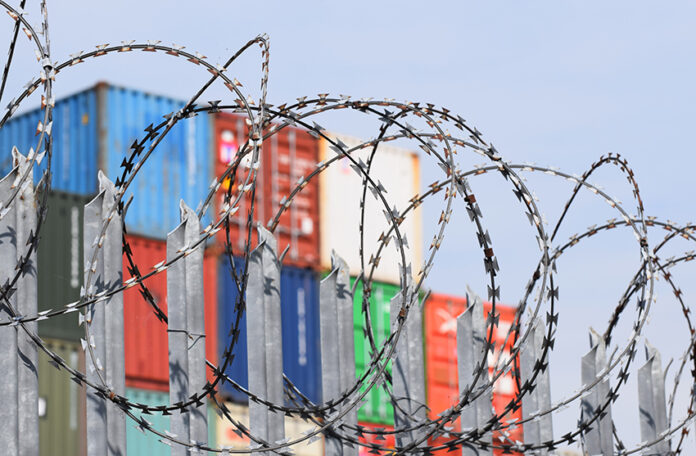
U.S. President Donald Trump’s latest tariff threat and its potential impact on next year’s mandatory revision of the U.S.-Mexico-Canada free trade agreement (USMCA) could extend Mexico’s economic uncertainty into 2027.
According to J.P. Morgan economist Gabriel Lozano, the review of the USMCA might not be as routine as previously thought, and this could hamstring investment decisions for another two years.
Mark Carney says USMCA is a basis for a broader talks on trade and that it will have to change, and that Trump has taken advantage of deal with the tariffs. pic.twitter.com/llyNvFvLRt
— Courtney Theriault (@cspotweet) May 6, 2025
“Our baseline scenario is that the USMCA review will begin in October as scheduled,” Lozano told the newspaper El Economista. “But we’re already beginning to see a risk that … the imposition of recurring tariffs could mean we might not have an agreement until 2027.”
This unpredictability prompted J.P. Morgan to maintain its forecast of 0% growth this year for Mexico and just 1% growth next year, Lozano said. Other reputable forecasters give similar figures of 0.1% and 0.2% growth this year.
“We are anticipating a relatively moderate recovery and a mediocre growth rate,” he said, adding that this calculation does not yet take into account the impact that the draconian U.S. immigration policy will have on remittances.
Increasingly massive deportations will directly impact consumer spending in Mexico, Lozano said.
A dangerous precedent?
Kenneth Smith, a partner at the Agon-Economía/Derecho/Estrategia consulting firm and Mexico’s chief negotiator during USMCA talks in 2017-2018, agreed with Lozano’s comments about the double blow of tariffs and the USMCA revision.
During a discussion panel organized by the Mexican Institute for Competitiveness (IMCO) this week, Smith said the U.S. is setting a dangerous precedent with the “temporary” tariffs Trump has employed this year.
Mexico currently faces three types of U.S. tariffs that already affect key sectors.
Since Trump took office on Jan. 20, Mexico has had to deal with 25% tariffs on products that don’t meet USMCA rules of origin, selective levies on the automotive sector and 50% tariffs on steel and aluminum.
Now President Claudia Sheinbaum is dealing with the potential imposition of an across-the-board 30% tariff beginning Aug. 1.
Smith warned that the tariffs imposed by the United States on Mexico could become the new foundation of the USMCA, suggesting U.S. negotiators could seek to make the tariffs permanent.
“The tariffs being applied as temporary measures could end up being incorporated as permanent rules during the treaty review,” Smith warned.
Mexico’s auto industry is preparing for just such a scenario, according to Odracir Barquera, president of the Mexican Automotive Industry Association (AMIA).

“We can’t be sure of the U.S. posture yet,” he told the Cluster Industrial website, “but indications are it will feature an aggressive, unilateral strategy.”
Barquera said he wouldn’t be surprised if the U.S. seeks to significantly hike the regional content requirements. He also suggested labor requirements could be stiffened. Originally conceived as a routine review, next year’s USMCA revision could become a window for profound changes, Smith warned, recalling that Mexico and Canada fought to eliminate a “sudden death” clause. Such a provision would have allowed any of the three participating nations to terminate the agreement at any time.
The trade tensions resulting from Trump’s aggressive tariff policy have already cost Mexico tremendously, according to the U.N.’s Economic Commission for Latin America and the Caribbean (CEPAL).
CEPAL’s Marco Llinás, citing data from Mexico’s central bank, told the newspaper La Jornada that the uncertainty caused by the tariff threats likely resulted in a 21% drop in foreign direct investment during the first quarter of 2025.
CEPAL’s executive secretary, José Manuel Salazar-Xirinachs, said U.S. protectionist trade policy could force Mexico to significantly diversify trade relations. Currently, 80% of Mexico’s exports are shipped to the United States.
With reports from El Economista, El Financiero, Cluster Industrial and La Jornada
Eva Longoria’s docuseries on Club Necaxa is set to premiere in early August

Hollywood actress and director Eva Longoria has taken a deep dive into her Mexican roots by producing a 10-episode docudrama focused on the storied Mexican soccer team Club Necaxa, which will air in Mexico and the United States in early August.
The project, produced in partnership with Necaxa co-owners Ryan Reynolds and Rob Mac (formerly Rob McElhenney), will appeal to the legions of fans that Necaxa has attracted over more than a century of existence. But it also has more substantive aims, exploring the club’s ups and downs, its more recent relaunch as the Rayos del Necaxa in Aguascalientes, and the business reality behind it all.
(1/2) Eva Longoria es la nueva directora de un espectáculo llamado Necaxa. “Los deportes en vivo son la última frontera del storytelling” y lo dice desde Aguascalientes: transformar al Necaxa, no solo como equipo, sino como historia viva. pic.twitter.com/VPANKNrbNh
— GQ México y Latam (@GQMexico) May 29, 2025
Longoria, 50, best known for her role in Desperate Housewives, has fashioned a second career as an entrepreneur and is also a co-owner of Club Necaxa. Though U.S.-born, her parents are Mexican and Spanish.
“My commitment to Necaxa is personal,” Longoria says in an online teaser for the show. “I want to show the world the beauty of the Mexican people … One day you can be the underdog and the next day you can become a soccer giant.”
Club Necaxa is one of the original members of what would become Mexico’s professional soccer league (Federación Mexicana de Fútbol) after it was founded in 1922 by the Scotsman William H. Frasser. Players could not be paid in those days, so Frasser simply allowed employees of the electricity company he owned to participate on the team as part of their workload. Not coincidentally, the team was known as the electricistas (electricians) and took its official name from the Necaxa River that supplied water to the power company.
The home games were played in various stadiums in Mexico City, including one in Condesa. It wasn’t until after the turn of the century that the team moved to Aguascalientes.
According to the official trailer, there is much focus on stories about the club and its significance in Mexican culture, including clips of the team interacting with its fans. There is also, according to FX, another participant in the production, footage of the team’s performance during the most recent Apertura and Clausura (the two seasons completed each year in Mexican soccer).
One important premise in the show (titled simply “Necaxa”) is the club’s resurgence following the arrival of new investors. It will show training sessions, athletes’ injuries, administrative decisions and the former powerhouse’s task of regaining its place of honor in Liga MX.
“A passionate core of die-hard fans continues to believe, clinging to the dream that their beloved Rayos will one day rise again,” the description of the TV show says, highlighting the resilience of a team that continues to bring pride to its city despite its many challenges.
The project brings together several production companies such as Hyphenate Media Group (owned by Eva Longoria), Maximum Effort (founded by Ryan Reynolds), More Better Productions (owned by Rob Mac), and 3 Arts Entertainment.
The show’s premiere is scheduled for Aug. 7 via the streaming platform Hulu in the United States. The Mexican audience will have access to it the following day via Disney Plus. Two of the 10 episodes will be released during each of the first three weeks, followed by one episode every Friday through the last episode will air on Sept. 19.
With reports from Record, Diario Las Américas and Infobae
